Financial Analysis of Sony Corporation: Business Organization Report
VerifiedAdded on 2023/04/06
|83
|13746
|326
Report
AI Summary
This report presents a comprehensive financial analysis of Sony Corporation, examining its balance sheet, profit and loss (P&L) account, and cash flow statement from 2014 to 2018. It includes trend and horizontal analyses of the balance sheet, assessing fixed and current assets, liabilities, and shareholders' equity. The P&L analysis focuses on income, expenditure, and profit trends. A detailed cash flow analysis is conducted, followed by a thorough ratio analysis, including liquidity, profitability, efficiency, financial structure, and valuation ratios. The report also incorporates a DuPont analysis and a scenario analysis to evaluate the company's performance and shareholding patterns, concluding with key findings and recommendations based on the financial data presented.
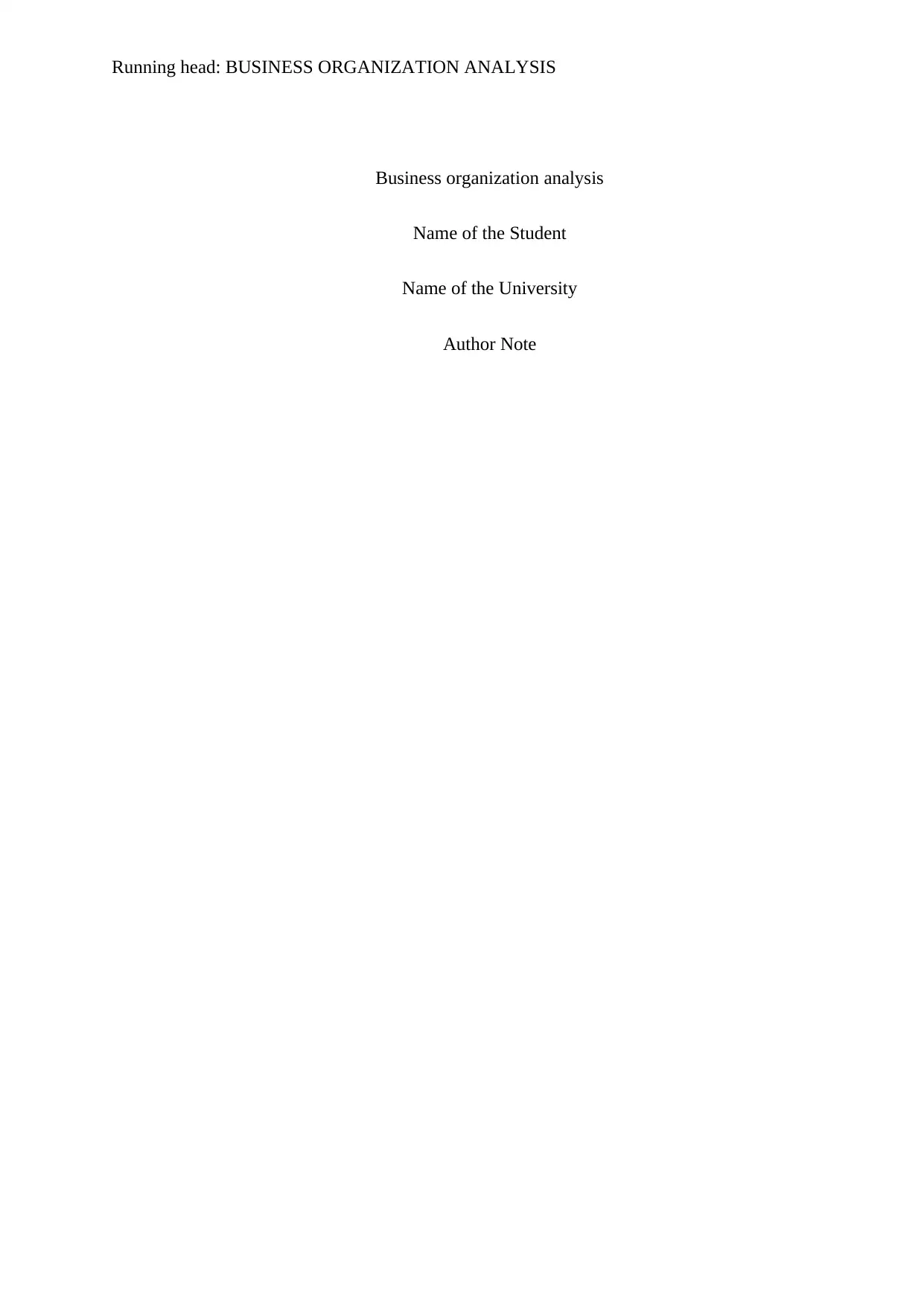
Running head: BUSINESS ORGANIZATION ANALYSIS
Business organization analysis
Name of the Student
Name of the University
Author Note
Business organization analysis
Name of the Student
Name of the University
Author Note
Paraphrase This Document
Need a fresh take? Get an instant paraphrase of this document with our AI Paraphraser
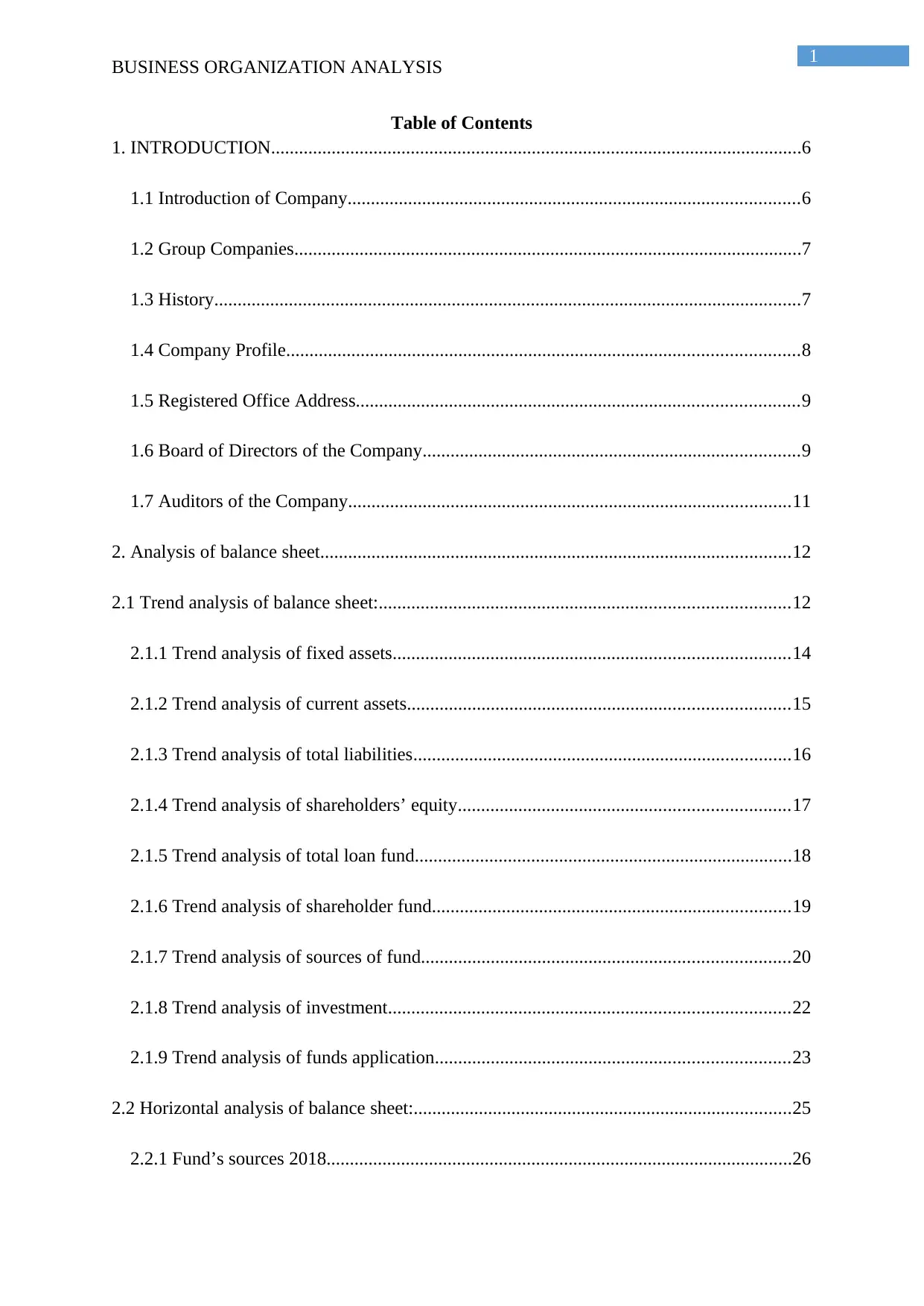
1
BUSINESS ORGANIZATION ANALYSIS
Table of Contents
1. INTRODUCTION..................................................................................................................6
1.1 Introduction of Company.................................................................................................6
1.2 Group Companies.............................................................................................................7
1.3 History..............................................................................................................................7
1.4 Company Profile..............................................................................................................8
1.5 Registered Office Address...............................................................................................9
1.6 Board of Directors of the Company.................................................................................9
1.7 Auditors of the Company...............................................................................................11
2. Analysis of balance sheet.....................................................................................................12
2.1 Trend analysis of balance sheet:........................................................................................12
2.1.1 Trend analysis of fixed assets.....................................................................................14
2.1.2 Trend analysis of current assets..................................................................................15
2.1.3 Trend analysis of total liabilities.................................................................................16
2.1.4 Trend analysis of shareholders’ equity.......................................................................17
2.1.5 Trend analysis of total loan fund.................................................................................18
2.1.6 Trend analysis of shareholder fund.............................................................................19
2.1.7 Trend analysis of sources of fund...............................................................................20
2.1.8 Trend analysis of investment......................................................................................22
2.1.9 Trend analysis of funds application............................................................................23
2.2 Horizontal analysis of balance sheet:.................................................................................25
2.2.1 Fund’s sources 2018....................................................................................................26
BUSINESS ORGANIZATION ANALYSIS
Table of Contents
1. INTRODUCTION..................................................................................................................6
1.1 Introduction of Company.................................................................................................6
1.2 Group Companies.............................................................................................................7
1.3 History..............................................................................................................................7
1.4 Company Profile..............................................................................................................8
1.5 Registered Office Address...............................................................................................9
1.6 Board of Directors of the Company.................................................................................9
1.7 Auditors of the Company...............................................................................................11
2. Analysis of balance sheet.....................................................................................................12
2.1 Trend analysis of balance sheet:........................................................................................12
2.1.1 Trend analysis of fixed assets.....................................................................................14
2.1.2 Trend analysis of current assets..................................................................................15
2.1.3 Trend analysis of total liabilities.................................................................................16
2.1.4 Trend analysis of shareholders’ equity.......................................................................17
2.1.5 Trend analysis of total loan fund.................................................................................18
2.1.6 Trend analysis of shareholder fund.............................................................................19
2.1.7 Trend analysis of sources of fund...............................................................................20
2.1.8 Trend analysis of investment......................................................................................22
2.1.9 Trend analysis of funds application............................................................................23
2.2 Horizontal analysis of balance sheet:.................................................................................25
2.2.1 Fund’s sources 2018....................................................................................................26
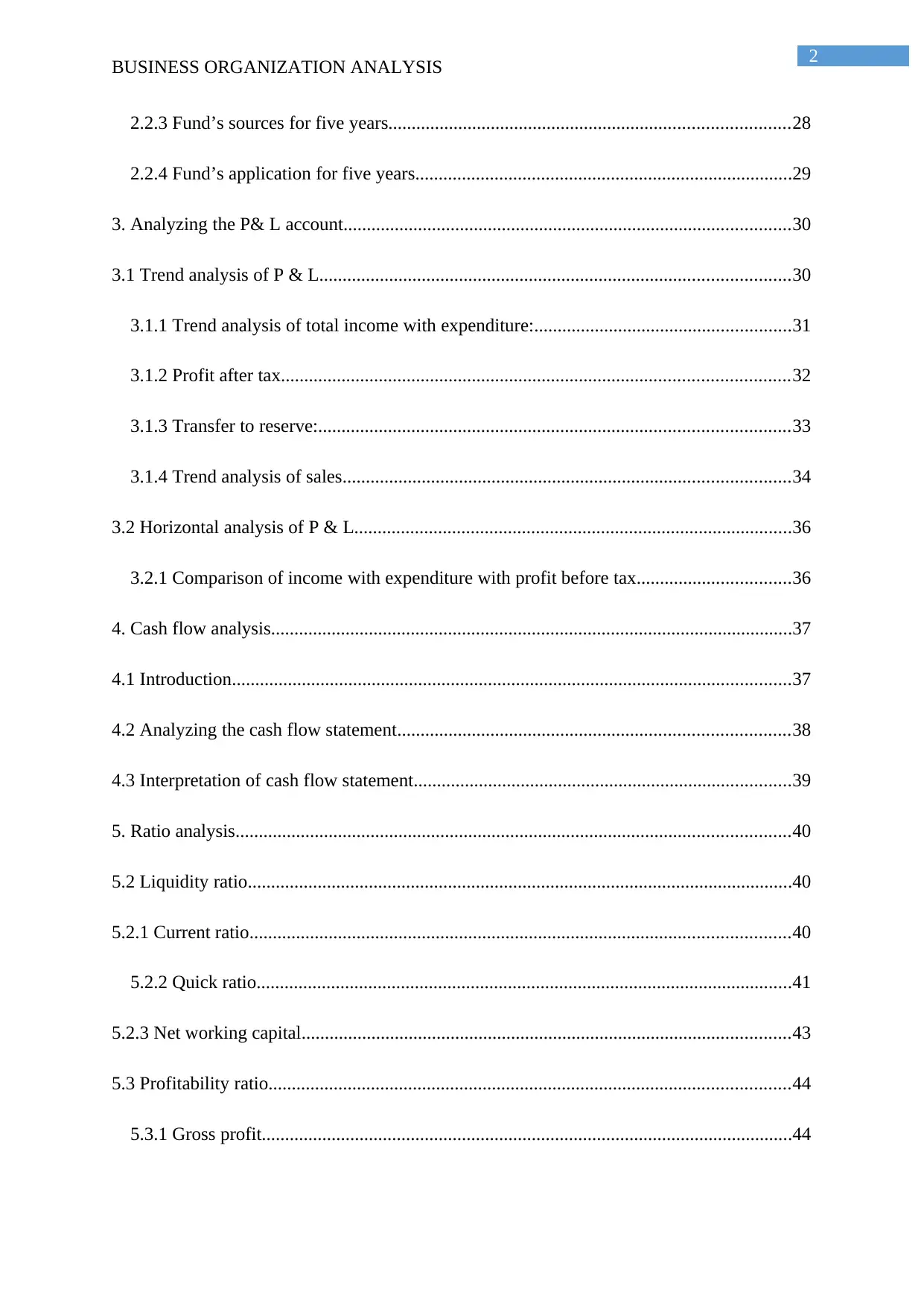
2
BUSINESS ORGANIZATION ANALYSIS
2.2.3 Fund’s sources for five years......................................................................................28
2.2.4 Fund’s application for five years.................................................................................29
3. Analyzing the P& L account................................................................................................30
3.1 Trend analysis of P & L.....................................................................................................30
3.1.1 Trend analysis of total income with expenditure:.......................................................31
3.1.2 Profit after tax.............................................................................................................32
3.1.3 Transfer to reserve:.....................................................................................................33
3.1.4 Trend analysis of sales................................................................................................34
3.2 Horizontal analysis of P & L..............................................................................................36
3.2.1 Comparison of income with expenditure with profit before tax.................................36
4. Cash flow analysis................................................................................................................37
4.1 Introduction........................................................................................................................37
4.2 Analyzing the cash flow statement....................................................................................38
4.3 Interpretation of cash flow statement.................................................................................39
5. Ratio analysis.......................................................................................................................40
5.2 Liquidity ratio.....................................................................................................................40
5.2.1 Current ratio....................................................................................................................40
5.2.2 Quick ratio...................................................................................................................41
5.2.3 Net working capital.........................................................................................................43
5.3 Profitability ratio................................................................................................................44
5.3.1 Gross profit..................................................................................................................44
BUSINESS ORGANIZATION ANALYSIS
2.2.3 Fund’s sources for five years......................................................................................28
2.2.4 Fund’s application for five years.................................................................................29
3. Analyzing the P& L account................................................................................................30
3.1 Trend analysis of P & L.....................................................................................................30
3.1.1 Trend analysis of total income with expenditure:.......................................................31
3.1.2 Profit after tax.............................................................................................................32
3.1.3 Transfer to reserve:.....................................................................................................33
3.1.4 Trend analysis of sales................................................................................................34
3.2 Horizontal analysis of P & L..............................................................................................36
3.2.1 Comparison of income with expenditure with profit before tax.................................36
4. Cash flow analysis................................................................................................................37
4.1 Introduction........................................................................................................................37
4.2 Analyzing the cash flow statement....................................................................................38
4.3 Interpretation of cash flow statement.................................................................................39
5. Ratio analysis.......................................................................................................................40
5.2 Liquidity ratio.....................................................................................................................40
5.2.1 Current ratio....................................................................................................................40
5.2.2 Quick ratio...................................................................................................................41
5.2.3 Net working capital.........................................................................................................43
5.3 Profitability ratio................................................................................................................44
5.3.1 Gross profit..................................................................................................................44
⊘ This is a preview!⊘
Do you want full access?
Subscribe today to unlock all pages.

Trusted by 1+ million students worldwide
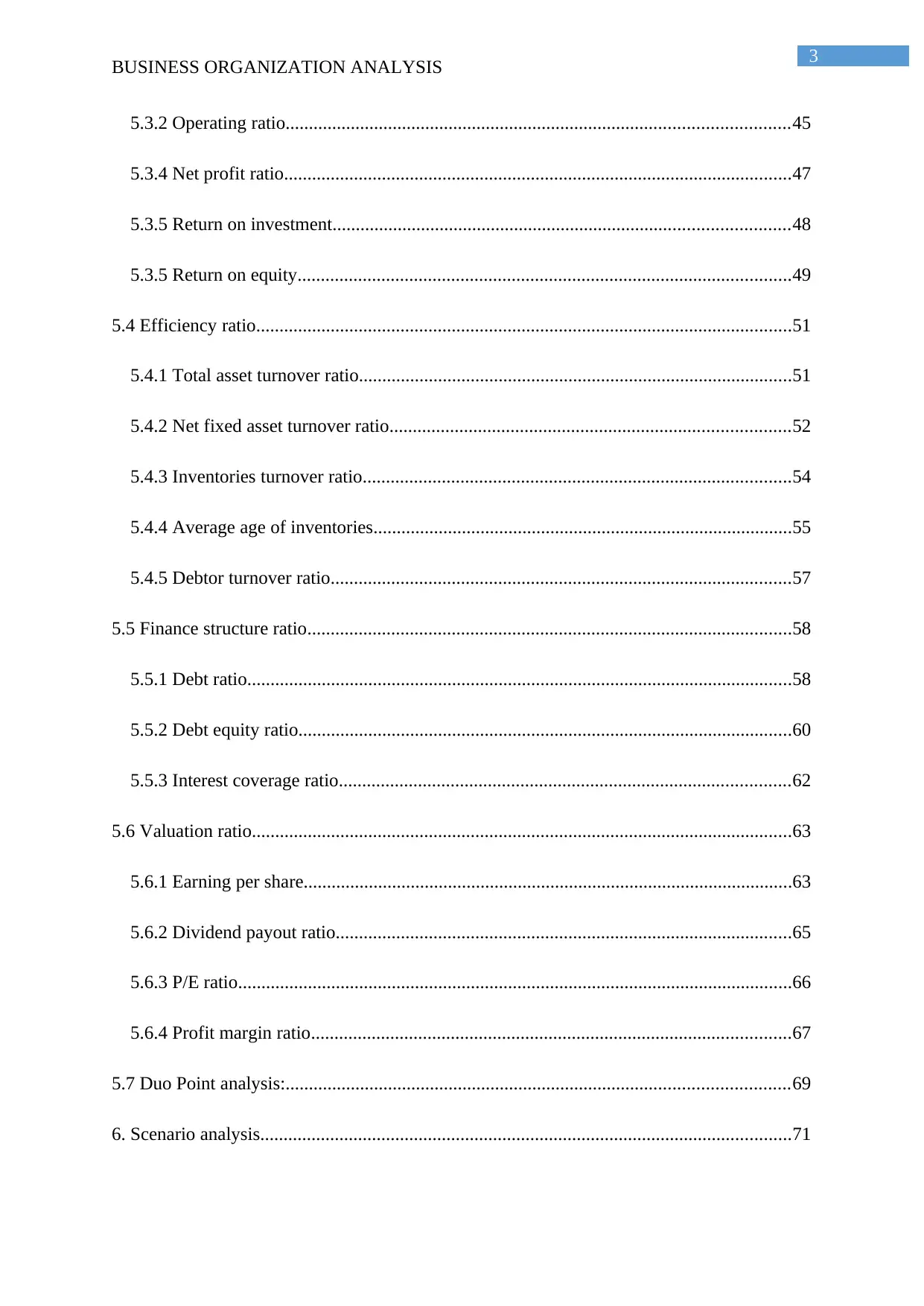
3
BUSINESS ORGANIZATION ANALYSIS
5.3.2 Operating ratio............................................................................................................45
5.3.4 Net profit ratio.............................................................................................................47
5.3.5 Return on investment..................................................................................................48
5.3.5 Return on equity..........................................................................................................49
5.4 Efficiency ratio...................................................................................................................51
5.4.1 Total asset turnover ratio.............................................................................................51
5.4.2 Net fixed asset turnover ratio......................................................................................52
5.4.3 Inventories turnover ratio............................................................................................54
5.4.4 Average age of inventories..........................................................................................55
5.4.5 Debtor turnover ratio...................................................................................................57
5.5 Finance structure ratio........................................................................................................58
5.5.1 Debt ratio.....................................................................................................................58
5.5.2 Debt equity ratio..........................................................................................................60
5.5.3 Interest coverage ratio.................................................................................................62
5.6 Valuation ratio....................................................................................................................63
5.6.1 Earning per share.........................................................................................................63
5.6.2 Dividend payout ratio..................................................................................................65
5.6.3 P/E ratio.......................................................................................................................66
5.6.4 Profit margin ratio.......................................................................................................67
5.7 Duo Point analysis:............................................................................................................69
6. Scenario analysis..................................................................................................................71
BUSINESS ORGANIZATION ANALYSIS
5.3.2 Operating ratio............................................................................................................45
5.3.4 Net profit ratio.............................................................................................................47
5.3.5 Return on investment..................................................................................................48
5.3.5 Return on equity..........................................................................................................49
5.4 Efficiency ratio...................................................................................................................51
5.4.1 Total asset turnover ratio.............................................................................................51
5.4.2 Net fixed asset turnover ratio......................................................................................52
5.4.3 Inventories turnover ratio............................................................................................54
5.4.4 Average age of inventories..........................................................................................55
5.4.5 Debtor turnover ratio...................................................................................................57
5.5 Finance structure ratio........................................................................................................58
5.5.1 Debt ratio.....................................................................................................................58
5.5.2 Debt equity ratio..........................................................................................................60
5.5.3 Interest coverage ratio.................................................................................................62
5.6 Valuation ratio....................................................................................................................63
5.6.1 Earning per share.........................................................................................................63
5.6.2 Dividend payout ratio..................................................................................................65
5.6.3 P/E ratio.......................................................................................................................66
5.6.4 Profit margin ratio.......................................................................................................67
5.7 Duo Point analysis:............................................................................................................69
6. Scenario analysis..................................................................................................................71
Paraphrase This Document
Need a fresh take? Get an instant paraphrase of this document with our AI Paraphraser
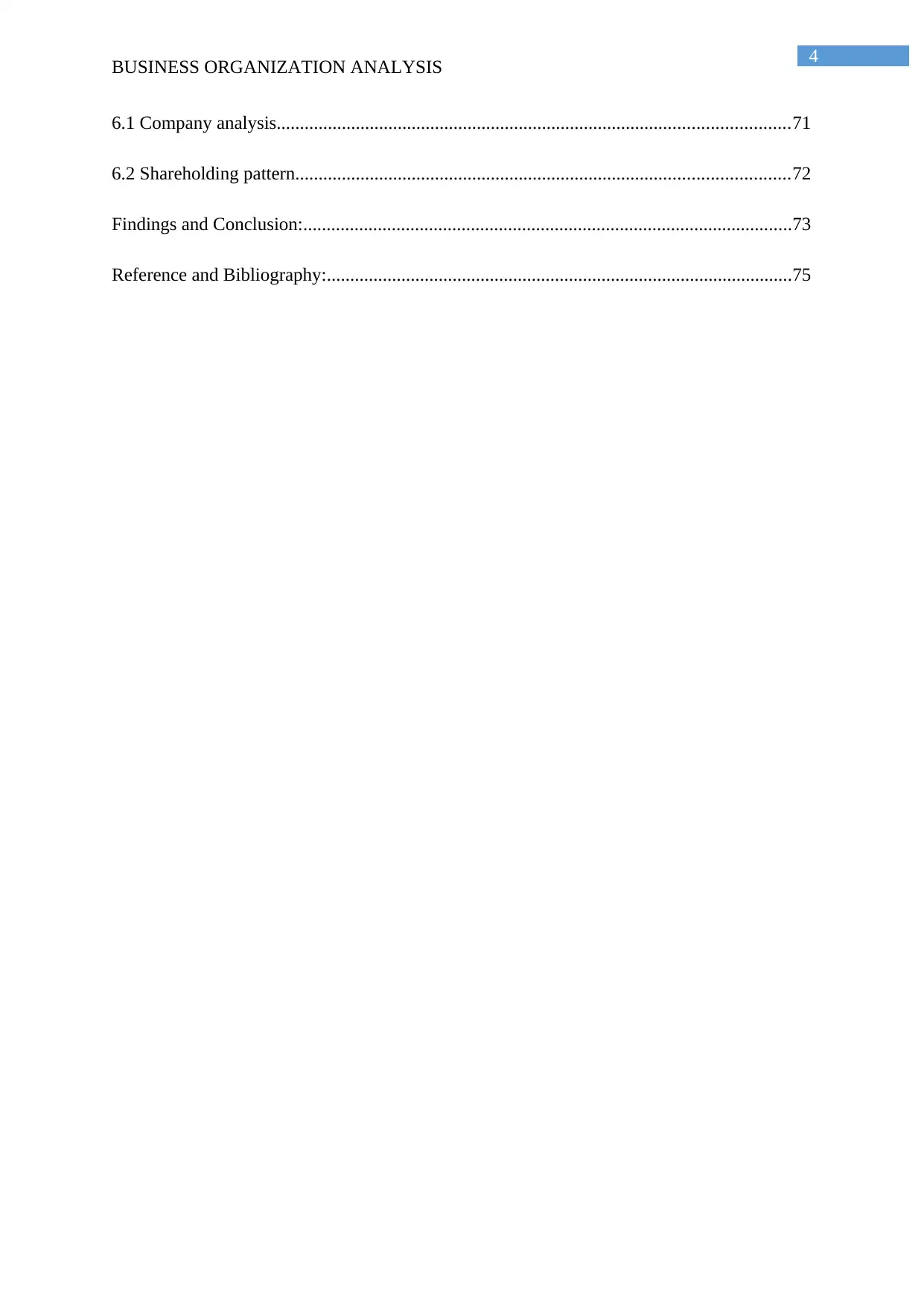
4
BUSINESS ORGANIZATION ANALYSIS
6.1 Company analysis..............................................................................................................71
6.2 Shareholding pattern..........................................................................................................72
Findings and Conclusion:.........................................................................................................73
Reference and Bibliography:....................................................................................................75
BUSINESS ORGANIZATION ANALYSIS
6.1 Company analysis..............................................................................................................71
6.2 Shareholding pattern..........................................................................................................72
Findings and Conclusion:.........................................................................................................73
Reference and Bibliography:....................................................................................................75
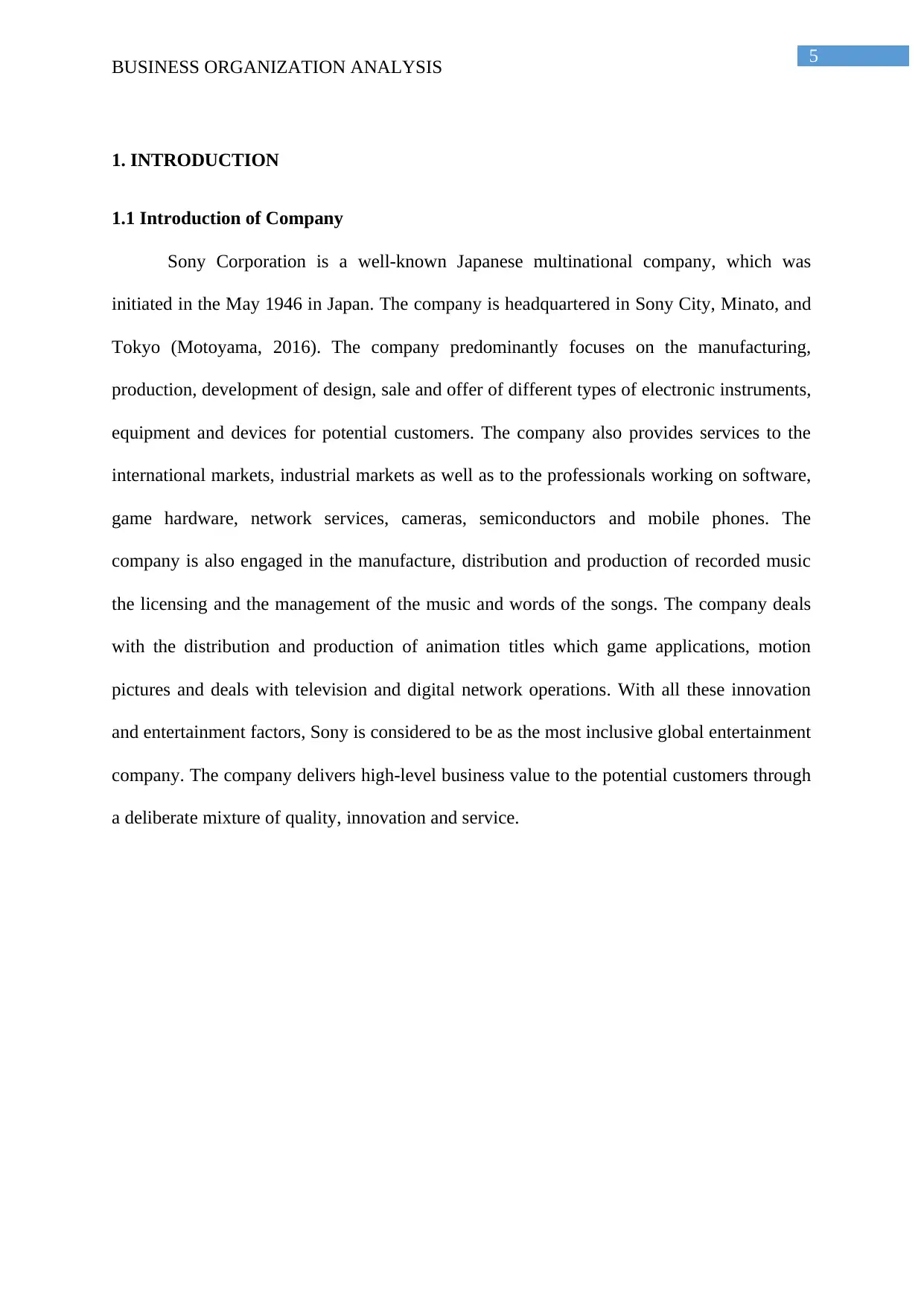
5
BUSINESS ORGANIZATION ANALYSIS
1. INTRODUCTION
1.1 Introduction of Company
Sony Corporation is a well-known Japanese multinational company, which was
initiated in the May 1946 in Japan. The company is headquartered in Sony City, Minato, and
Tokyo (Motoyama, 2016). The company predominantly focuses on the manufacturing,
production, development of design, sale and offer of different types of electronic instruments,
equipment and devices for potential customers. The company also provides services to the
international markets, industrial markets as well as to the professionals working on software,
game hardware, network services, cameras, semiconductors and mobile phones. The
company is also engaged in the manufacture, distribution and production of recorded music
the licensing and the management of the music and words of the songs. The company deals
with the distribution and production of animation titles which game applications, motion
pictures and deals with television and digital network operations. With all these innovation
and entertainment factors, Sony is considered to be as the most inclusive global entertainment
company. The company delivers high-level business value to the potential customers through
a deliberate mixture of quality, innovation and service.
BUSINESS ORGANIZATION ANALYSIS
1. INTRODUCTION
1.1 Introduction of Company
Sony Corporation is a well-known Japanese multinational company, which was
initiated in the May 1946 in Japan. The company is headquartered in Sony City, Minato, and
Tokyo (Motoyama, 2016). The company predominantly focuses on the manufacturing,
production, development of design, sale and offer of different types of electronic instruments,
equipment and devices for potential customers. The company also provides services to the
international markets, industrial markets as well as to the professionals working on software,
game hardware, network services, cameras, semiconductors and mobile phones. The
company is also engaged in the manufacture, distribution and production of recorded music
the licensing and the management of the music and words of the songs. The company deals
with the distribution and production of animation titles which game applications, motion
pictures and deals with television and digital network operations. With all these innovation
and entertainment factors, Sony is considered to be as the most inclusive global entertainment
company. The company delivers high-level business value to the potential customers through
a deliberate mixture of quality, innovation and service.
⊘ This is a preview!⊘
Do you want full access?
Subscribe today to unlock all pages.

Trusted by 1+ million students worldwide
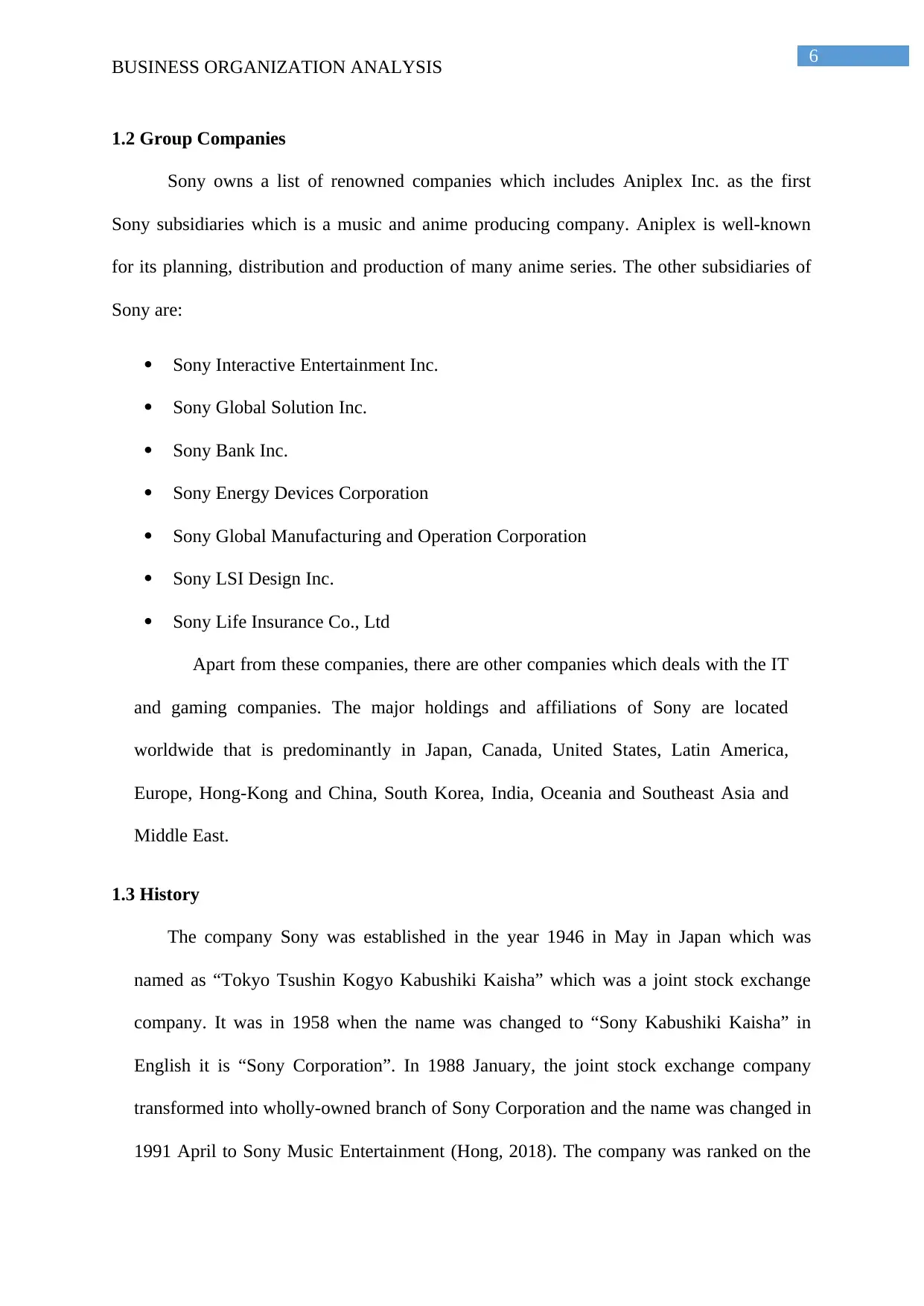
6
BUSINESS ORGANIZATION ANALYSIS
1.2 Group Companies
Sony owns a list of renowned companies which includes Aniplex Inc. as the first
Sony subsidiaries which is a music and anime producing company. Aniplex is well-known
for its planning, distribution and production of many anime series. The other subsidiaries of
Sony are:
Sony Interactive Entertainment Inc.
Sony Global Solution Inc.
Sony Bank Inc.
Sony Energy Devices Corporation
Sony Global Manufacturing and Operation Corporation
Sony LSI Design Inc.
Sony Life Insurance Co., Ltd
Apart from these companies, there are other companies which deals with the IT
and gaming companies. The major holdings and affiliations of Sony are located
worldwide that is predominantly in Japan, Canada, United States, Latin America,
Europe, Hong-Kong and China, South Korea, India, Oceania and Southeast Asia and
Middle East.
1.3 History
The company Sony was established in the year 1946 in May in Japan which was
named as “Tokyo Tsushin Kogyo Kabushiki Kaisha” which was a joint stock exchange
company. It was in 1958 when the name was changed to “Sony Kabushiki Kaisha” in
English it is “Sony Corporation”. In 1988 January, the joint stock exchange company
transformed into wholly-owned branch of Sony Corporation and the name was changed in
1991 April to Sony Music Entertainment (Hong, 2018). The company was ranked on the
BUSINESS ORGANIZATION ANALYSIS
1.2 Group Companies
Sony owns a list of renowned companies which includes Aniplex Inc. as the first
Sony subsidiaries which is a music and anime producing company. Aniplex is well-known
for its planning, distribution and production of many anime series. The other subsidiaries of
Sony are:
Sony Interactive Entertainment Inc.
Sony Global Solution Inc.
Sony Bank Inc.
Sony Energy Devices Corporation
Sony Global Manufacturing and Operation Corporation
Sony LSI Design Inc.
Sony Life Insurance Co., Ltd
Apart from these companies, there are other companies which deals with the IT
and gaming companies. The major holdings and affiliations of Sony are located
worldwide that is predominantly in Japan, Canada, United States, Latin America,
Europe, Hong-Kong and China, South Korea, India, Oceania and Southeast Asia and
Middle East.
1.3 History
The company Sony was established in the year 1946 in May in Japan which was
named as “Tokyo Tsushin Kogyo Kabushiki Kaisha” which was a joint stock exchange
company. It was in 1958 when the name was changed to “Sony Kabushiki Kaisha” in
English it is “Sony Corporation”. In 1988 January, the joint stock exchange company
transformed into wholly-owned branch of Sony Corporation and the name was changed in
1991 April to Sony Music Entertainment (Hong, 2018). The company was ranked on the
Paraphrase This Document
Need a fresh take? Get an instant paraphrase of this document with our AI Paraphraser
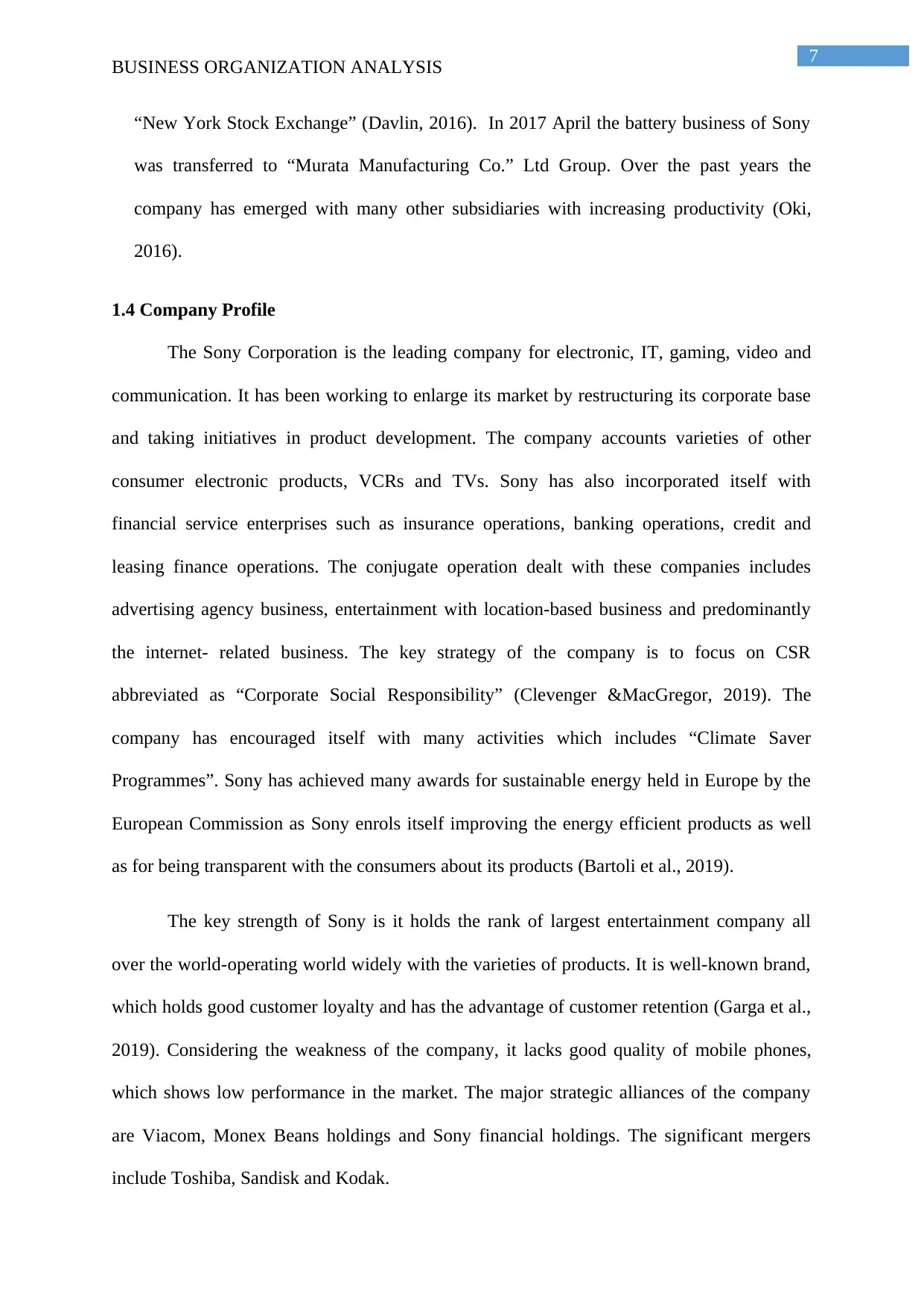
7
BUSINESS ORGANIZATION ANALYSIS
“New York Stock Exchange” (Davlin, 2016). In 2017 April the battery business of Sony
was transferred to “Murata Manufacturing Co.” Ltd Group. Over the past years the
company has emerged with many other subsidiaries with increasing productivity (Oki,
2016).
1.4 Company Profile
The Sony Corporation is the leading company for electronic, IT, gaming, video and
communication. It has been working to enlarge its market by restructuring its corporate base
and taking initiatives in product development. The company accounts varieties of other
consumer electronic products, VCRs and TVs. Sony has also incorporated itself with
financial service enterprises such as insurance operations, banking operations, credit and
leasing finance operations. The conjugate operation dealt with these companies includes
advertising agency business, entertainment with location-based business and predominantly
the internet- related business. The key strategy of the company is to focus on CSR
abbreviated as “Corporate Social Responsibility” (Clevenger &MacGregor, 2019). The
company has encouraged itself with many activities which includes “Climate Saver
Programmes”. Sony has achieved many awards for sustainable energy held in Europe by the
European Commission as Sony enrols itself improving the energy efficient products as well
as for being transparent with the consumers about its products (Bartoli et al., 2019).
The key strength of Sony is it holds the rank of largest entertainment company all
over the world-operating world widely with the varieties of products. It is well-known brand,
which holds good customer loyalty and has the advantage of customer retention (Garga et al.,
2019). Considering the weakness of the company, it lacks good quality of mobile phones,
which shows low performance in the market. The major strategic alliances of the company
are Viacom, Monex Beans holdings and Sony financial holdings. The significant mergers
include Toshiba, Sandisk and Kodak.
BUSINESS ORGANIZATION ANALYSIS
“New York Stock Exchange” (Davlin, 2016). In 2017 April the battery business of Sony
was transferred to “Murata Manufacturing Co.” Ltd Group. Over the past years the
company has emerged with many other subsidiaries with increasing productivity (Oki,
2016).
1.4 Company Profile
The Sony Corporation is the leading company for electronic, IT, gaming, video and
communication. It has been working to enlarge its market by restructuring its corporate base
and taking initiatives in product development. The company accounts varieties of other
consumer electronic products, VCRs and TVs. Sony has also incorporated itself with
financial service enterprises such as insurance operations, banking operations, credit and
leasing finance operations. The conjugate operation dealt with these companies includes
advertising agency business, entertainment with location-based business and predominantly
the internet- related business. The key strategy of the company is to focus on CSR
abbreviated as “Corporate Social Responsibility” (Clevenger &MacGregor, 2019). The
company has encouraged itself with many activities which includes “Climate Saver
Programmes”. Sony has achieved many awards for sustainable energy held in Europe by the
European Commission as Sony enrols itself improving the energy efficient products as well
as for being transparent with the consumers about its products (Bartoli et al., 2019).
The key strength of Sony is it holds the rank of largest entertainment company all
over the world-operating world widely with the varieties of products. It is well-known brand,
which holds good customer loyalty and has the advantage of customer retention (Garga et al.,
2019). Considering the weakness of the company, it lacks good quality of mobile phones,
which shows low performance in the market. The major strategic alliances of the company
are Viacom, Monex Beans holdings and Sony financial holdings. The significant mergers
include Toshiba, Sandisk and Kodak.
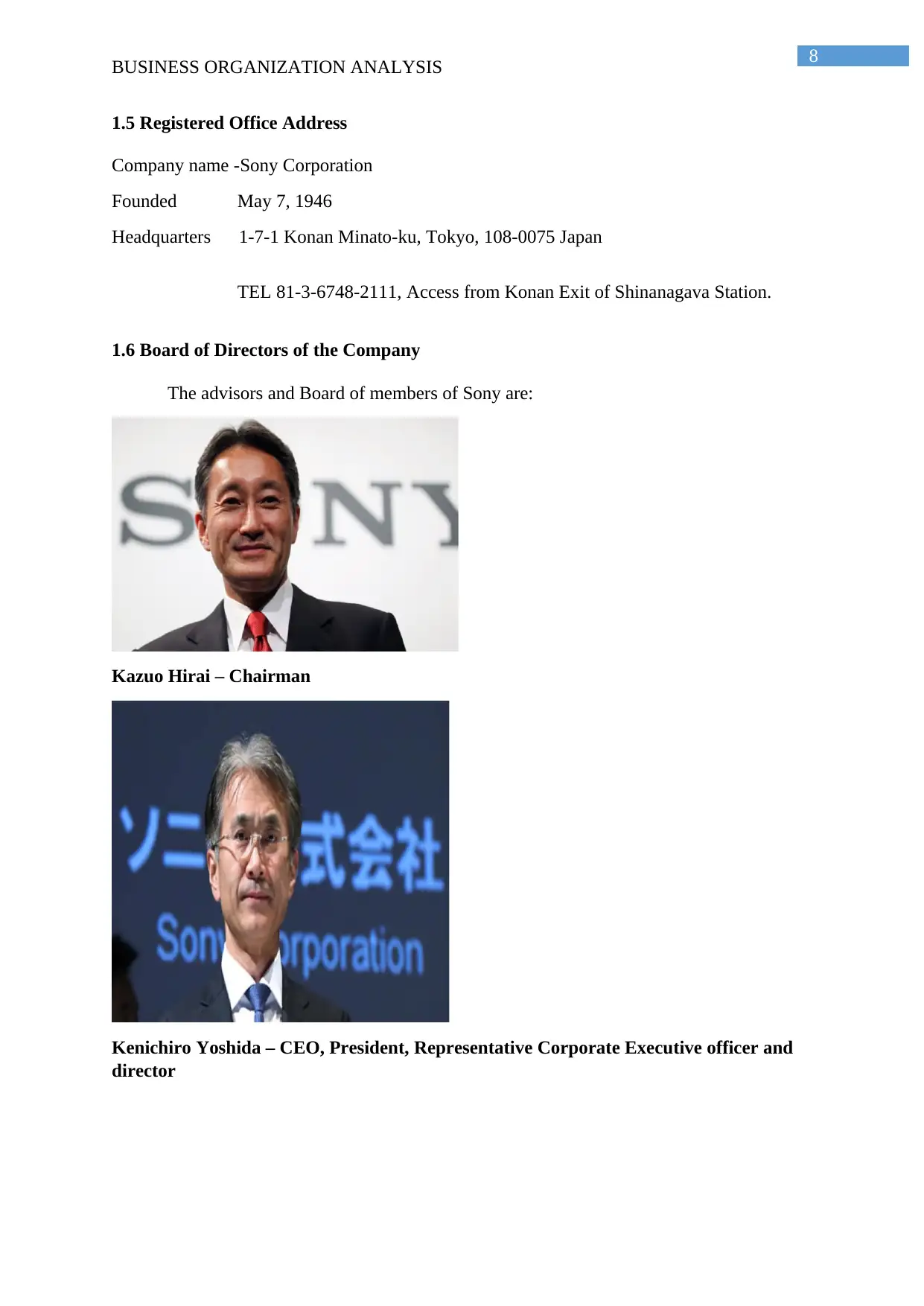
8
BUSINESS ORGANIZATION ANALYSIS
1.5 Registered Office Address
Company name -Sony Corporation
Founded May 7, 1946
Headquarters 1-7-1 Konan Minato-ku, Tokyo, 108-0075 Japan
TEL 81-3-6748-2111, Access from Konan Exit of Shinanagava Station.
1.6 Board of Directors of the Company
The advisors and Board of members of Sony are:
Kazuo Hirai – Chairman
Kenichiro Yoshida – CEO, President, Representative Corporate Executive officer and
director
BUSINESS ORGANIZATION ANALYSIS
1.5 Registered Office Address
Company name -Sony Corporation
Founded May 7, 1946
Headquarters 1-7-1 Konan Minato-ku, Tokyo, 108-0075 Japan
TEL 81-3-6748-2111, Access from Konan Exit of Shinanagava Station.
1.6 Board of Directors of the Company
The advisors and Board of members of Sony are:
Kazuo Hirai – Chairman
Kenichiro Yoshida – CEO, President, Representative Corporate Executive officer and
director
⊘ This is a preview!⊘
Do you want full access?
Subscribe today to unlock all pages.

Trusted by 1+ million students worldwide
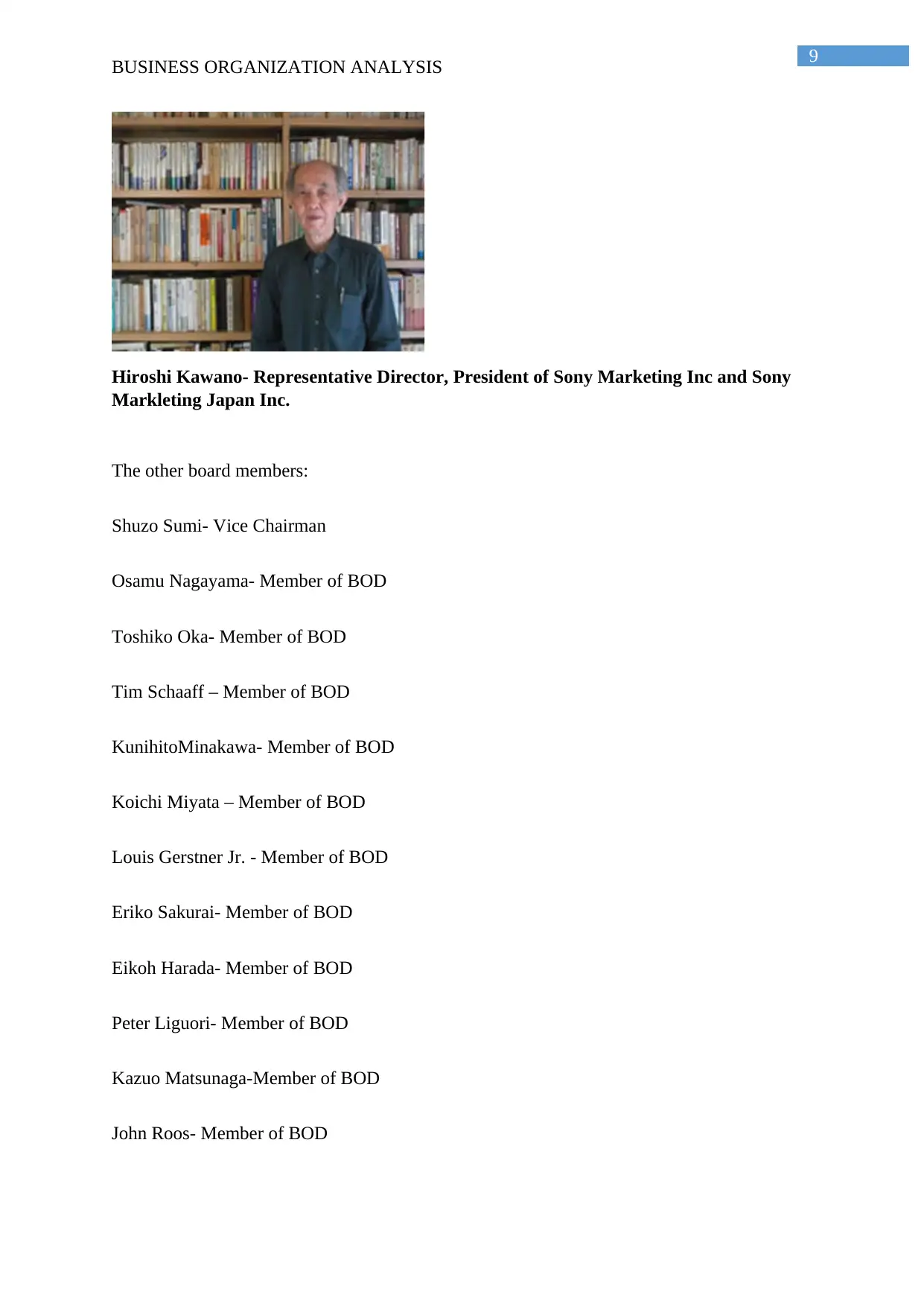
9
BUSINESS ORGANIZATION ANALYSIS
Hiroshi Kawano- Representative Director, President of Sony Marketing Inc and Sony
Markleting Japan Inc.
The other board members:
Shuzo Sumi- Vice Chairman
Osamu Nagayama- Member of BOD
Toshiko Oka- Member of BOD
Tim Schaaff – Member of BOD
KunihitoMinakawa- Member of BOD
Koichi Miyata – Member of BOD
Louis Gerstner Jr. - Member of BOD
Eriko Sakurai- Member of BOD
Eikoh Harada- Member of BOD
Peter Liguori- Member of BOD
Kazuo Matsunaga-Member of BOD
John Roos- Member of BOD
BUSINESS ORGANIZATION ANALYSIS
Hiroshi Kawano- Representative Director, President of Sony Marketing Inc and Sony
Markleting Japan Inc.
The other board members:
Shuzo Sumi- Vice Chairman
Osamu Nagayama- Member of BOD
Toshiko Oka- Member of BOD
Tim Schaaff – Member of BOD
KunihitoMinakawa- Member of BOD
Koichi Miyata – Member of BOD
Louis Gerstner Jr. - Member of BOD
Eriko Sakurai- Member of BOD
Eikoh Harada- Member of BOD
Peter Liguori- Member of BOD
Kazuo Matsunaga-Member of BOD
John Roos- Member of BOD
Paraphrase This Document
Need a fresh take? Get an instant paraphrase of this document with our AI Paraphraser
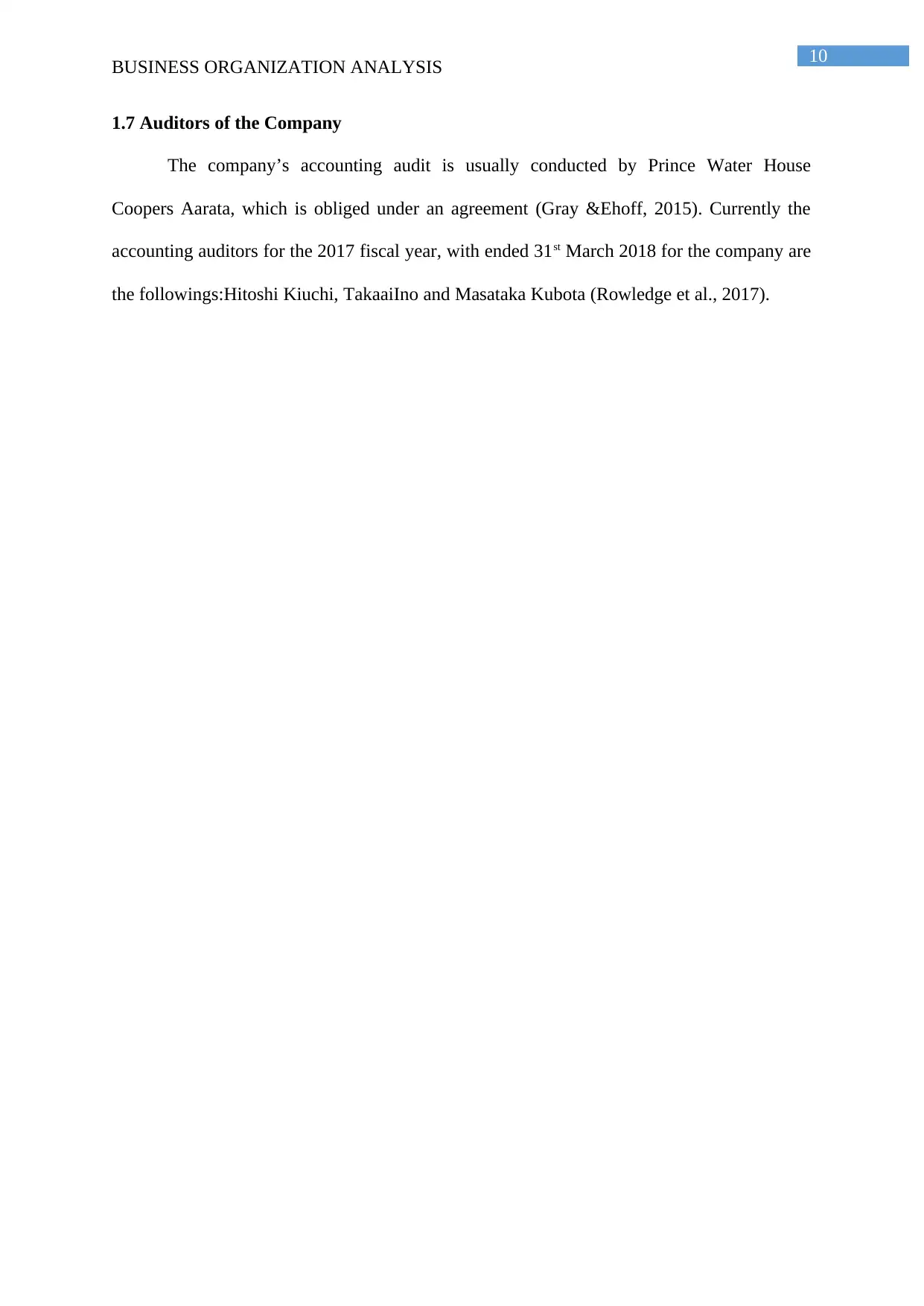
10
BUSINESS ORGANIZATION ANALYSIS
1.7 Auditors of the Company
The company’s accounting audit is usually conducted by Prince Water House
Coopers Aarata, which is obliged under an agreement (Gray &Ehoff, 2015). Currently the
accounting auditors for the 2017 fiscal year, with ended 31st March 2018 for the company are
the followings:Hitoshi Kiuchi, TakaaiIno and Masataka Kubota (Rowledge et al., 2017).
BUSINESS ORGANIZATION ANALYSIS
1.7 Auditors of the Company
The company’s accounting audit is usually conducted by Prince Water House
Coopers Aarata, which is obliged under an agreement (Gray &Ehoff, 2015). Currently the
accounting auditors for the 2017 fiscal year, with ended 31st March 2018 for the company are
the followings:Hitoshi Kiuchi, TakaaiIno and Masataka Kubota (Rowledge et al., 2017).
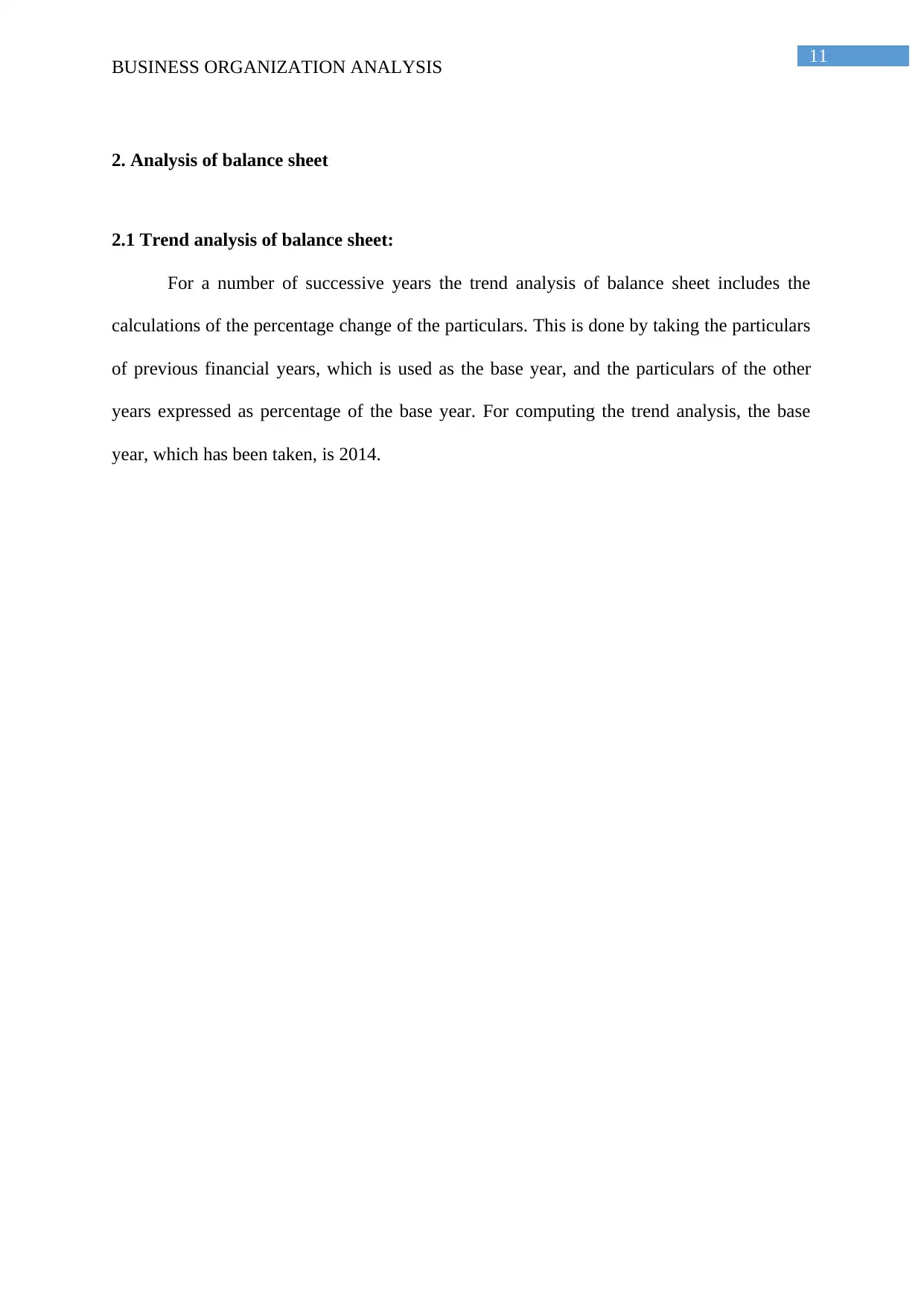
11
BUSINESS ORGANIZATION ANALYSIS
2. Analysis of balance sheet
2.1 Trend analysis of balance sheet:
For a number of successive years the trend analysis of balance sheet includes the
calculations of the percentage change of the particulars. This is done by taking the particulars
of previous financial years, which is used as the base year, and the particulars of the other
years expressed as percentage of the base year. For computing the trend analysis, the base
year, which has been taken, is 2014.
BUSINESS ORGANIZATION ANALYSIS
2. Analysis of balance sheet
2.1 Trend analysis of balance sheet:
For a number of successive years the trend analysis of balance sheet includes the
calculations of the percentage change of the particulars. This is done by taking the particulars
of previous financial years, which is used as the base year, and the particulars of the other
years expressed as percentage of the base year. For computing the trend analysis, the base
year, which has been taken, is 2014.
⊘ This is a preview!⊘
Do you want full access?
Subscribe today to unlock all pages.

Trusted by 1+ million students worldwide
1 out of 83
Related Documents
Your All-in-One AI-Powered Toolkit for Academic Success.
+13062052269
info@desklib.com
Available 24*7 on WhatsApp / Email
![[object Object]](/_next/static/media/star-bottom.7253800d.svg)
Unlock your academic potential
Copyright © 2020–2025 A2Z Services. All Rights Reserved. Developed and managed by ZUCOL.





